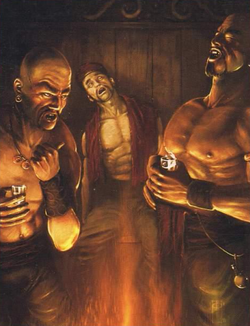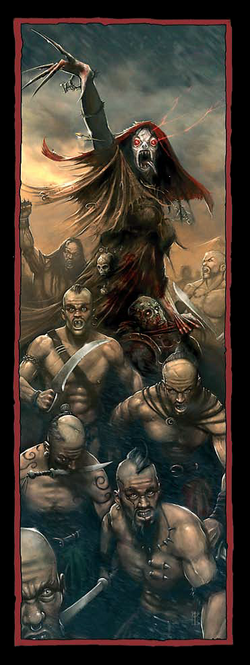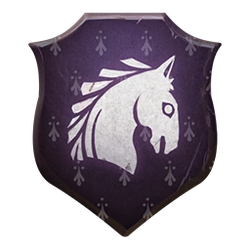
The Ungols are the fierce horse-archers who inhabit much of northern Kislev.
The Ungols are a nomadic tribe of Men who inhabited the land now known as Kislev before the arrival of the people who would eventually mix bloodlines and cultures with them to become the Kislevites, the nomadic tribesmen then known as the Gospodars.[2a]
History[]
The Ungols originally dominated a neighbouring tribe known as the Roppsmenn but also lived alongside another people known as the Teutogens who bordered their territory. Later, the Ungols fought against the barbaric marauders called the Norsii, forcing them further northwards into the frozen land that is nowNorsca. The Norsii first arrived in Ungol lands as a result of being forced into what would become Kislev by the armies of Sigmar Heldenhammer, as the Unberogen king moved to unite the lands of what would become the Empire.[2a]

A Hag Witch in the form of the Ancient Widow leading a group of Ungols to war.
Sigmar provided military assistance to the Ungols by aiding them in fighting off the Orcs and Goblins of the Worlds Edge Mountains before the two peoples allied to end the Greenskin menace to the Old World once and for all at the First Battle of Black Fire Pass. Afterwards, a peace was established between the two peoples.[2a]
The end of Ungol dominance in what became the lands of Kislev was marked by the arrival of another tribe of nomadic horsemen called the Gospodars over the High Pass from the Endless Steppes in ca. -30 of the Gospodarin Calendar (1494 IC). The Gospodars quickly overran the Ungols' cities and other habitations and they were forced further westward into Roppsmenn country. Under the rule of their warlord Hethis Chaq, the Ungols fought a Roppsmenn host led by King Wieran up to the cliffs overlooking the Sea of Claws. Here the Roppsmenn people, the vassals of the Ungols, were broken and scattered forever, and are now largely believed to be extinct.[2a]
Norvard was the greatest city of the Ungols, until it was overrun and renamed Erengrad by the Gospodars. After this grave defeat, the Ungols were effectively beaten by the invaders. The Ungols submitted uneasily to the rule of the Gospodars thereafter and soon the two peoples began to mix together until the Ungols were largely absorbed into the larger Gospodar population, essentially forming a united Kislevite people.[2a]
Legacy[]

Heraldry of the Ungol Kindred as seen in Total War: Warhammer III.
Although they were defeated by the Gospodars, the culture of the Ungols lives on as a part of the present-day culture of Kislev. The city of Praag has a large Ungol population, and some would say that the Ungols have more influence there than the Gospodars do.[2a]
Some of the fastest Kislevite cavalry archers are actually of Ungol blood, and are still known as the Ungol Horse Archers. They are watched over closely by the Gospodars for any signs of disloyalty, but are used throughout the lands of Kislev due to their speed of deployment and their intimate knowledge of the ground.[2a]
Additionally, the Kossars, the infantrymen of Kislev, were once a tribe of mercenary Ungol warriors. They are now a combined force of Ungol and Gospodars, an attempt to bind the two peoples together within the Kislevite military as well as in the wider culture.[2a]
"Piss-drinker" is a term of derision for those Kislevites who live in the most northern regions of the Old World, referencing the Ungol practice of drinking the blood of their horses and their own urine if fresh water resources had been used up during journeys into the Chaos Wastes.[4a]
Trivia[]
The Ungols are likely based on the Zaporozhian Cossacks, a nomadic Cossack group that inhabited the wild steppes of present-day central Ukraine. They were subjects of the Polish-Lithuanian Commonwealth and later the Tsardom of Russia, two of the real-world inspirations for Kislev, but retained a great deal of autonomy until they were forcibly disbanded in the late 18th century by Catherine the Great.
Likewise, their role as the first line of defence against invading eastern nomadic hordes like the Mongolks is similar to the Kazan Tatars, who were a nomadic Turkic tribe that played a key role in the Mongol invasion of Kievan Rus' in the 13th century.
